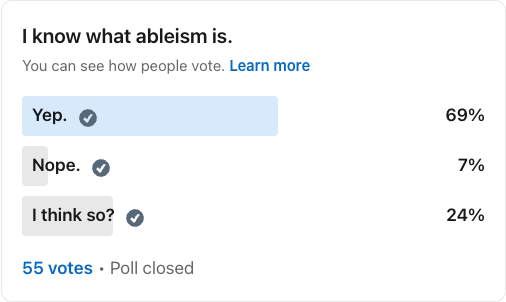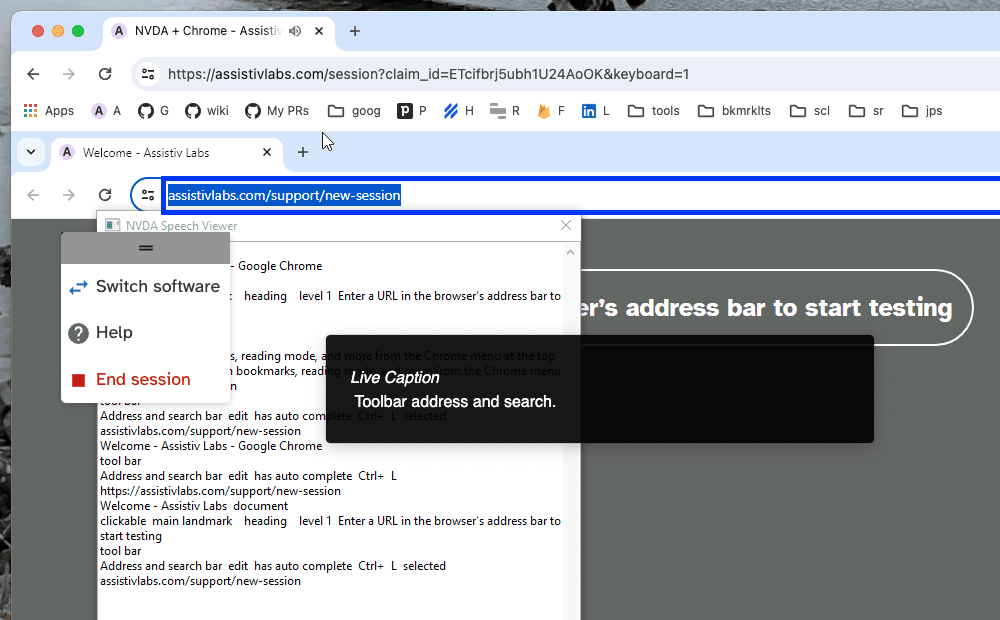We need to talk. About ableism.
The purpose of a system is what it does. Software built in the context of ableism far too often excludes Disabled people. What would it look like to take an accessibility-first approach to building the web?

The purpose of a system is what it does. Software built in the context of ableism far too often excludes Disabled people. What would it look like to take an accessibility-first approach to building the web?
The Assist is the official newsletter of Assistiv Labs. We build tools to help the people who make the web make it more inclusive. 💙
The Assist publishes 3 or 4 times per year and includes our perspective on trends in web accessibility, company and product updates, as well as tips & tricks and other news relevant to accessibility teams, developers, and QA professionals.
What if ableism wasn’t the default?
Ableism is a system of assigning value to people based on societal concepts of normalcy. (That’s the short version, so definitely read the linked article for the full definition!)
If ableism isn’t a concept you’re super familiar with, you’re not alone! We asked about it on LinkedIn recently and almost a third of respondents admitted not knowing how ableism is defined.

Ableism leads to so many of the barriers that get created in the world because it leads people to assume. Assume everyone can see. Assume everyone can hear. Use a mouse. Follow long run-on sentences full of dense, technical jargon. The list goes on…
What these assumptions lead to are web experiences that block people from participating, almost always unnecessarily. What would it take to turn these assumptions on their head? What would it look like to take an accessibility-first approach to building the web?
We’re glad you asked! Our good friend, EJ Mason, is here to help. As EJ so eloquently says, “If web practitioners want to make the web a better place, we must confront our priorities. We must talk about ableism.”
Read EJ’s ableism article. We expect you’ll come away motivated to do some introspection and make some changes to how you approach your work.
Identity + Disability
The esteemed Dr Michele A Williams has been sharing informative posts to LinkedIn that explore pivotal figures at the intersection of identity and disability.
We didn’t want them to end up lost to the algorithm, so we invited her to share them as compilations on our site. First up is Black History + Disability.

Pro tip: Dr Michele has started posting about Asian Americans and Pacific Islanders (AAPI) Month. Follow her on LinkedIn to keep up on this and the rest of her informative content!
How Chrome’s Live Caption feature delivers STT
Accessibility testers, did you know that screen reader speech viewers lie? 🤦
Fortunately, Google Chrome now supports speech-to-text (STT) for Assistiv Labs sessions via their Live Caption feature. This can make you a more effective tester by helping you understand what does and doesn’t get announced by the screen reader.

Read about how to use Chrome Live Caption for better accessibility testing.
We gave NVDA a new BFF based on the latest WebAIM survey results.
Have you ever wondered how we decide on the default browser to pair with each assistive technology on our live testing platform? TL;dr, WebAIM. WebAIM is the answer.
Our goal with our live testing platform is to provide default browser/screen reader pairings that match as closely as possible what users of assistive technologies use the most, under the theory that our customers most want to test the combinations most used by real users.

The best source of information about those combinations is WebAIM’s Screen Reader User Survey Results. The 10th edition of the survey was published recently and it turns out Google Chrome is now the browser most often paired with NVDA.
NVDA’s In-Process blog post from February 29 mentioned the trend:
One interesting statistic was that not only was Chrome used by 52.3% of respondents overall, but also by over half of NVDA users who completed the survey. We know Firefox has traditionally been a popular browser choice with NVDA users. That is still true, and I think what the result represents is that many users keep multiple browsers on hand and switch between them as needed.
To better match this new reality, we’ve updated our live-testing platform, making Google Chrome the default browser for NVDA. ✅
Fan of this change? Not so much? Let us know what you think!
Nonprofit discount now includes .edu! 🤑
You asked for it and we said, “Oh, that makes a ton of sense. Heck yes!” We have long offered a 15% discount on all subscriptions to registered nonprofits/charities. Now, users at public educational institutions are eligible as well.
Thanks for everything you do to make online learning accessible to all! 👏
To take advantage of this offer, send us an email at contact@assistivlabs.com from your .edu address.
Accessibility Camp Bay Area
We are proud to be sponsoring Accessibility Camp Bay Area’s 9th get together happening May 31, 2024. If you’re not familiar with Accessibility Camp, it’s a BarCamp-style conference for accessibility professionals that dates back to 2009. The Bay Area edition is coordinated by Jennison Asuncion, co-founder of Global Accessibility Awareness Day (GAAD). Andrew’s attending and giving a talk. If you’re there, don’t be shy, say hi!
Speaking of GAAD, who wants a free Assistiv Labs account?
Global Accessibility Awareness Day (GAAD) 2024 is coming up soon, May 16, to be exact! Many of the planned events are available to online attendees. How will you be spending that day?

Inspired by Scribely, we’re honoring GAAD by giving away 16 forever free Freelancer accounts. This will be a random drawing, so add your name using this Google Form or email us at contact@assistivlabs.com if you run into accessibility issues with the form.
We’ll do the draw on May 16, so throw your name in the hat today!
We hope you enjoyed this issue of The Assist! Let us know what you think by leaving a comment or sending us an email at contact@assistivlabs.com.